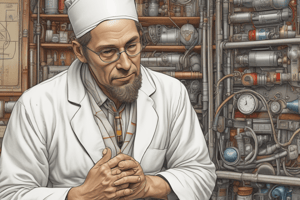Podcast
Questions and Answers
What significant report led to the creation of the National Health Service in 1948?
What significant report led to the creation of the National Health Service in 1948?
- The National Health Act
- The Beveridge Report (correct)
- The Welfare State Report
- The Health and Social Care Act
Which pioneering surgeon developed new skin graft techniques during World War One?
Which pioneering surgeon developed new skin graft techniques during World War One?
- Dr. Michael DeBakey
- James Edward Hanger
- Francis Derwent Wood
- Sir Harold Gillies (correct)
What was the purpose of the lifelike facial masks designed by Francis Derwent Wood?
What was the purpose of the lifelike facial masks designed by Francis Derwent Wood?
- To camouflage soldiers during combat
- To replace entire facial structures
- To improve soldiers' self-esteem and mental health (correct)
- To assist in the surgical recovery process
What innovation did James Edward Hanger contribute to during World War One?
What innovation did James Edward Hanger contribute to during World War One?
What type of injuries led to advances in surgery during World War One?
What type of injuries led to advances in surgery during World War One?
What was the effect of James Edward Hanger's observations in Europe on prosthetic limb design?
What was the effect of James Edward Hanger's observations in Europe on prosthetic limb design?
Which war contributed significantly to the advances in surgical techniques mentioned?
Which war contributed significantly to the advances in surgical techniques mentioned?
In the context of surgical advances, what did the term 'pedicle' refer to?
In the context of surgical advances, what did the term 'pedicle' refer to?
What was one major outcome of the National Health Service's establishment?
What was one major outcome of the National Health Service's establishment?
Which statement best describes the role of surgeons during World War One?
Which statement best describes the role of surgeons during World War One?
Flashcards
Shrapnel
Shrapnel
A hollow shell filled with small steel balls, often used in warfare, causing significant injuries to soldiers.
Plastic Surgery
Plastic Surgery
A type of surgery that reconstructs or repairs facial features; it was significantly advanced during World War One due to the high number of soldiers with facial injuries.
Skin Grafting with Pedicle
Skin Grafting with Pedicle
A surgical technique where a patch of skin, called a pedicle, is moved from one part of the body to another, while keeping the blood supply intact, used for facial reconstruction.
Francis Derwent Wood
Francis Derwent Wood
Signup and view all the flashcards
Limb Amputation
Limb Amputation
Signup and view all the flashcards
Hanger Prosthetic
Hanger Prosthetic
Signup and view all the flashcards
Beveridge Report
Beveridge Report
Signup and view all the flashcards
National Health Service (NHS)
National Health Service (NHS)
Signup and view all the flashcards
Blood Transfusions
Blood Transfusions
Signup and view all the flashcards
Trench Warfare
Trench Warfare
Signup and view all the flashcards
Study Notes
Surgical Advancements in World Wars One and Two
- Significant advancements in surgery, including plastic surgery and blood transfusions, occurred during World Wars One and Two.
- War injuries, from shrapnel, machine guns, and shell fire, prompted significant advancements in surgical techniques.
- Gillies pioneered new skin graft techniques. He developed a method involving moving a patch of skin (pedicle) with its blood supply to another part of the face.
- Francis Derwent Wood, a sculptor, created lifelike facial masks for soldiers with facial injuries to aid recovery, mental health, and reintegration.
Prosthetics and Amputations
- Amputations, such as removing arms or legs, were common during wartime.
- James Edward Hanger designed improved prosthetic limbs.
- He initially developed a better-fitting, bendable prosthesis for his own injury due to his engineering experience.
- Observation of the effects of trench warfare led to improved designs.
- Hanger's company received contracts from England and France for supplying artificial limbs to Allied soldiers.
National Health Service (NHS)
- The Beveridge Report led to the creation of the National Health Service (NHS) in 1948, providing free healthcare for all.
Studying That Suits You
Use AI to generate personalized quizzes and flashcards to suit your learning preferences.




